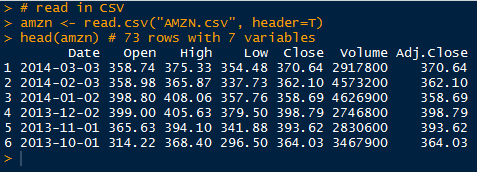Hello Readers,
Today we turn to the world of finance as we look into stock prices, specifically that of Amazon, Inc (AMZN). AMZN has been traded on the NASDAQ stock exchange since their IPO on May 15th, 1997 at 18.00 per share. Nowadays in 2014, AMZN trades around 369 dollars a share. Quite a long ways from a simple book selling company in Jeff Bezo's garage. I am sure Jeff Bezos is smiling. A lot.
 |
| Jeff Bezos, Founder and CEO/Chairman/President of Amazon |
At the Yahoo Finance site, we can download AMZN stock price data, such as the opening price, the high and low of the day, closing price, and the volume (number of stocks bought and sold). Check the beginning date is March 3, 2008, the end date is March 12, 2014 (when I retrieved the data), and prices are set to monthly. Then at the bottom of the chart, there is a 'Download to Spreadsheet' CSV link (or just click the link).
 |
| Download AMZN Prices from Yahoo Finance |
Now that we have the stock prices data, let us start number crunching to predict future Amazon stock prices in R.
AMZN in R
We need to import the CSV file into R. Locate the AMZN CSV file in your computer directory and write a read.csv() function pointing along the directory, making sure header=True. We will be using the closing prices.
 |
| Reading in CSV and AMZN Data |
We see from the first six rows in amzn, that the closing prices are in 5th column, and the prices are ordered from most recent to previous prices. When creating the time series, we need to reverse the 5th column, and specify the starting month and year with start=c(2008, 3). There are 12 monthly prices in a year so freq=12.
 |
| Creating AMZN Time Series and Data.frame |
In addition to the single time series, we can manipulate the data by taking the log of the values and placing both into an accessible data.frame.
Next we plot the AMZN stock prices to get an idea of any trends in the prices over the 6 years.
 |
| Plotting Both AMZN and log AMZN Prices |
Below we have the two plots, the AMZN stock price and the log of the AMZN stock price. We can see the obvious rise over the 6 years from 71.3 in March 2008 to 370.64 in March of 2014.
Observe the same upwards trend for the log of the stock prices. Note that fluctuations at lower values (around 2009) tend to produce greater effect when log transformed, since the values are the exponents of base e.
Decomposition
There is a function, stl(), which decomposes the amazon time series into seasonal, trend, and remainder components. stl() finds the seasonal component through loess smoothing (or taking the mean if s.window="periodic"). The seasonal component is removed from the data and the remainder is smoothed to find the trend. The residual component is calculated from seasonal plus trend fit residuals. Use the stl() function to decompose the closing prices in amazon, and plot the result.
 |
| amazon Decomposition |
See how variable the seasonal component is through the extreme values ranging from -5 to 10. There are also definitive peaks and valleys at specific times during the year. For example, in the 4th quarter (Q4- October, November, and December) this is a dramatic rise and fall in price by about 15 points.
Overall, the trend shown above depicts the expected upwards trend in stock price, besides the prices from 2008 into 2009, coinciding with the great financial collapse. Next we will use this output to forecast the price of AMZN stock in 2 years- March 2016.
Forecasting with stl()
Load the forecast package with the library() function. It enables us to forecast different time series models and linear models with the forecast() function. We specify our decomposed time series, amazon.stl, and determine our prediction method as "arima". Next we want to predict 24 periods into the future (or 24 months- 2 years), with a 95% confidence interval specified with level=95. Then we visualize our results by passing our forecast object through plot().
 |
| stl() ARIMA Forecasting AMZN |
We see the resulting (wonderful) plot below. Observe the forecast prices modeled and determined by auto.arima as the blue line, shadowed by the 95% confidence interval in grey. (ARIMA was cover in this post.) The model forecasts a likely increase of the AMZN stock price over 400 through year 2016.
The forecast values for AMZN through 2016 are shown below. The forecast for AMZN in March 2016 is 470.42, with a 95% confidence interval of the actual value lying between 333.96 and 606.88.
 |
| Forecast AMZN Values |
From that forecast, I would buy some AMZN stock! Especially after Amazon announced on March 14th that they would raise Amazon Prime membership by $20 to $99 a year for free two-day shipping, video streaming, and other features. Many analysts concluded this move would increase profits by millions and AMZN stock rose 1% (about 3.5 points). I am sure Jeff Bezos is smiling even more.
OK folks, hopefully now you have a better understanding of decomposition and forecasting time series! Check back for more analytic posts!
Thanks for reading,
Wayne
@beyondvalence





That's an interesting article! I'll keep reading your website.
ReplyDeleteAMZN